As you could see in the photo below, it displays the steel silo structure.
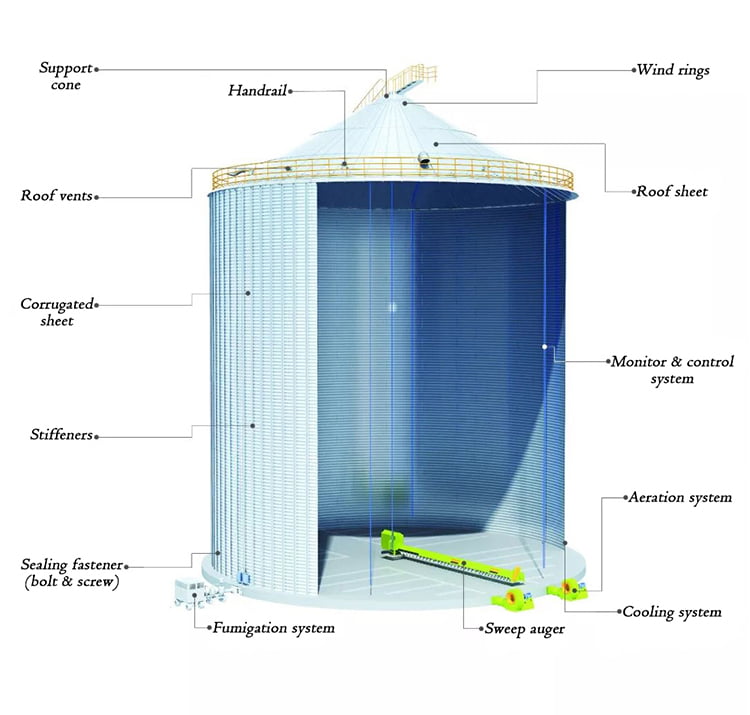
A silo includes five parts:
- Roof
- Cylindrical Body
- Bottom
- Control System
- Auxiliary Equipment
let’s go through the configuration of each part one by one.
The roof and cylindrical body of the flat bottom and cone bottom steel silos are the same, but their bottom is different.
So, we will introduce their different bottoms respectively in the following content.
Roof
The steel silo roof consists of the following common components:
Feed Inlet
When the drag conveyor is responsible for loading grain, its outlet connects to this feed inlet;
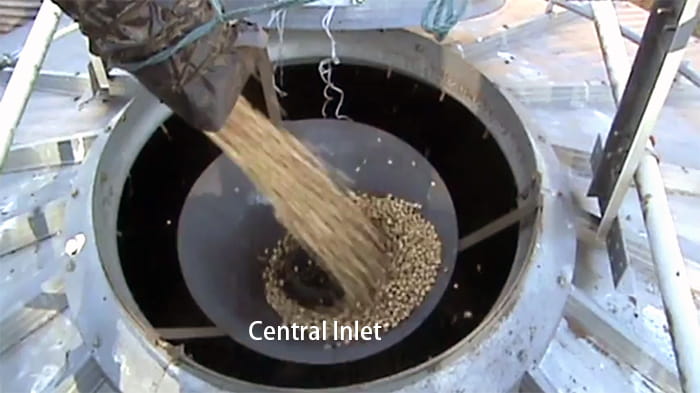
If the bucket elevator pours the grain directly into the chute for grain loading, the chute links to the feed inlet directly.
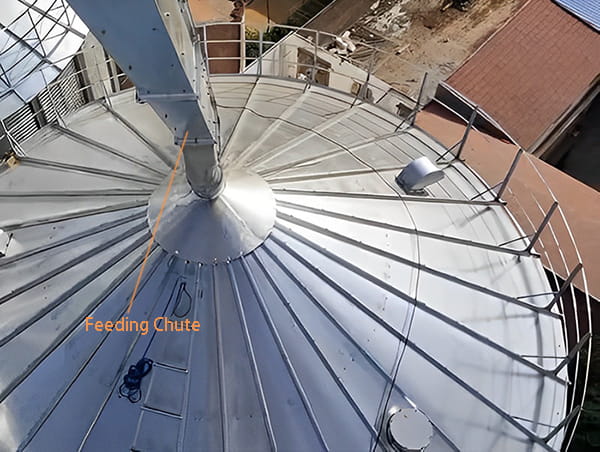
Top Collar
The top collar is a circular ring structure connected with the compression ring by purlins, forming the frame of the conical silo roof.
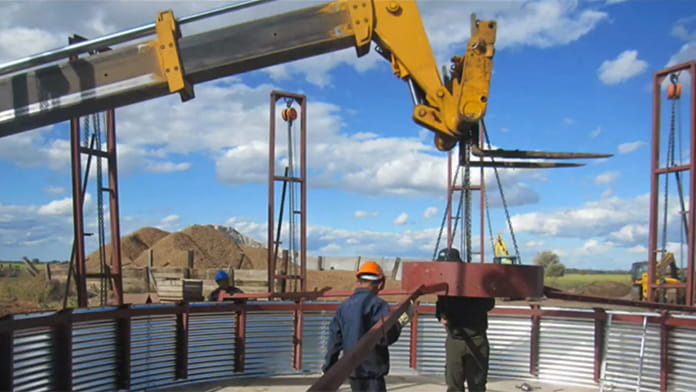
The feed inlet and top cover are fixed on the top collar.
To support the whole roof, the compression ring is fixed to the bin’s topmost rings of the body sheet by screws and nuts.
Purlin & Rafter
In fact, the small-diameter, small-capacity steel silo does not have purlins and rafters, and purlins and rafters often appear on large-diameter, high-capacity metal silos.
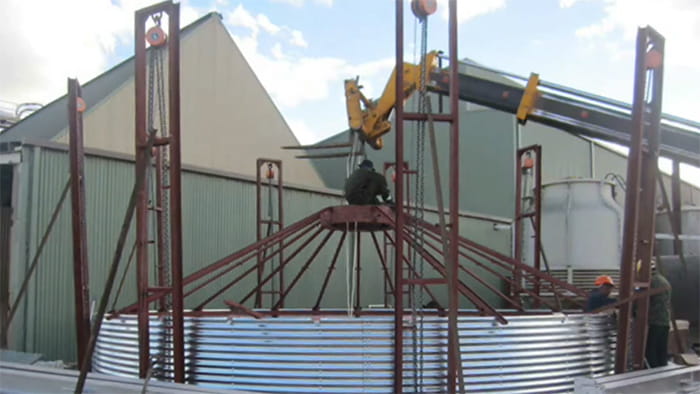
After adding purlins or rafters to the roof, the load capacity of the roof greatly increases, especially suitable for high latitude and cold regions.
Because there is a lot of snow in such areas during winter, the thick snow will cause great pressure on the roof.
Stiffening Ring
This stiffening ring is not integral but is surrounded by many reinforcement ribs spanning between two purlins.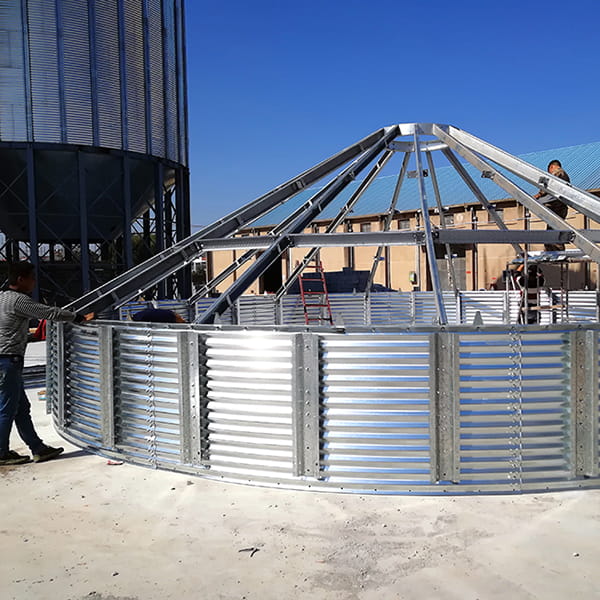
With its existence, the roof can bear a greater load, which helps increase the diameter and capacity of the entire galvanized silo.
Roof Panel
Roof panels are made of hot-dip galvanized sheets through cold roll forming and CNC punching.
It covers the purlins from the collar to the eaves to support snow loads.
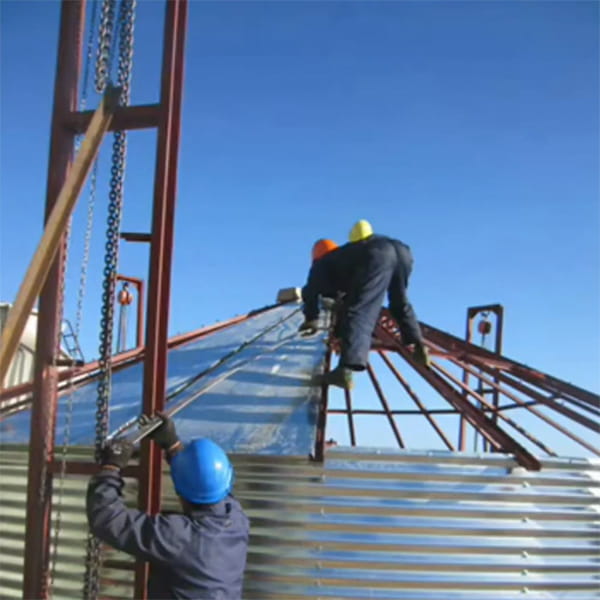
Its unique double-bending ribs make the roof panels tightly connected, firm, and non-deformed and have a stronger load-bearing capacity.
Wind Ring
When the installation site of the corrugated steel silo is in an area with strong wind, it is necessary to install a support ring on the roof to improve its wind resistance.
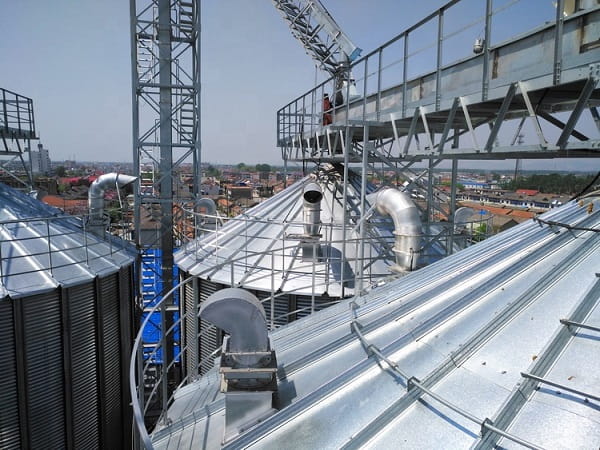
Compression Ring
It is fixed on the top cylindrical body panels and connected with the top collar through purlins, forming the frame of the silo roof.
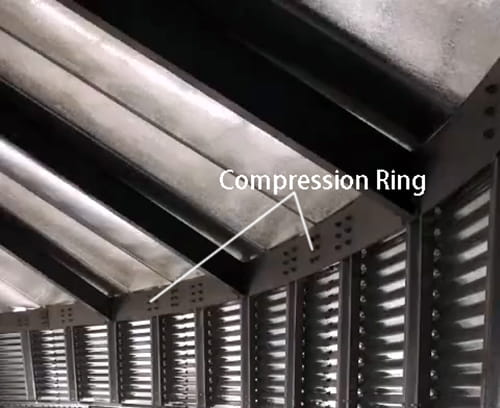
With the cylindrical body panels sharing the pressure, the compression ring supports the entire silo roof.
Catwalk
The catwalk on the roof supports the conveyor.
Workers can patrol above and maintain the silo and auxiliary equipment.
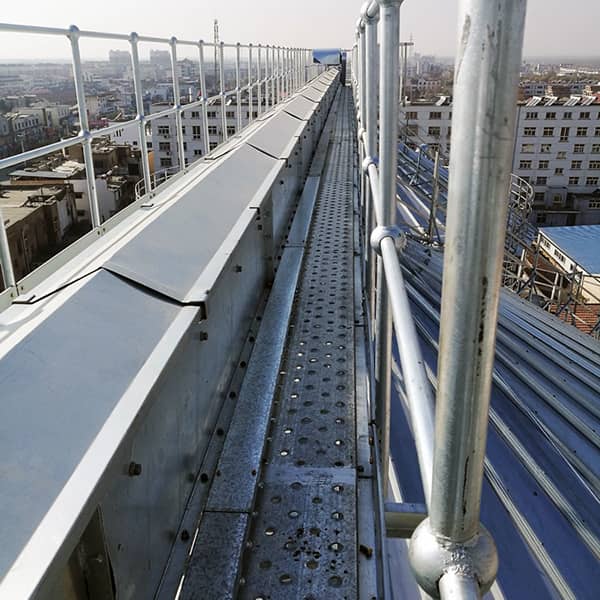
For large-capacity & large-diameter galvanized steel silos, since it equips with a heavy-duty conveyor, it is necessary to install an additional tower to support the catwalk.
The tower transfers the catwalk and conveyor loads directly to the ground without adding additional loads to the sidewall stiffeners.
Roof Ladder
The roof ladder connects the eaves and the top collar and serves as a road leading to the manhole and catwalk.
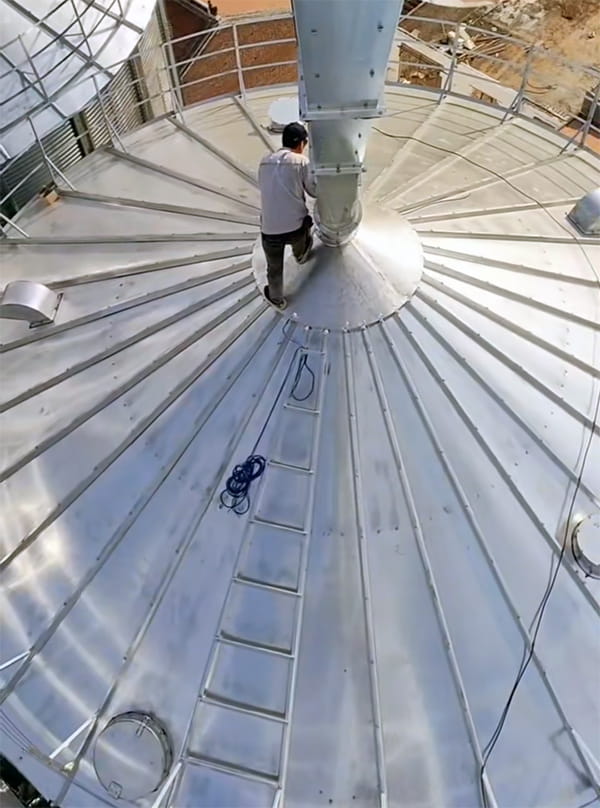
In order to improve safety, there are handrails on both sides of it.
Manhole
The manhole is suitable for observing the grain in the bin, a pressure closure fixes its door.
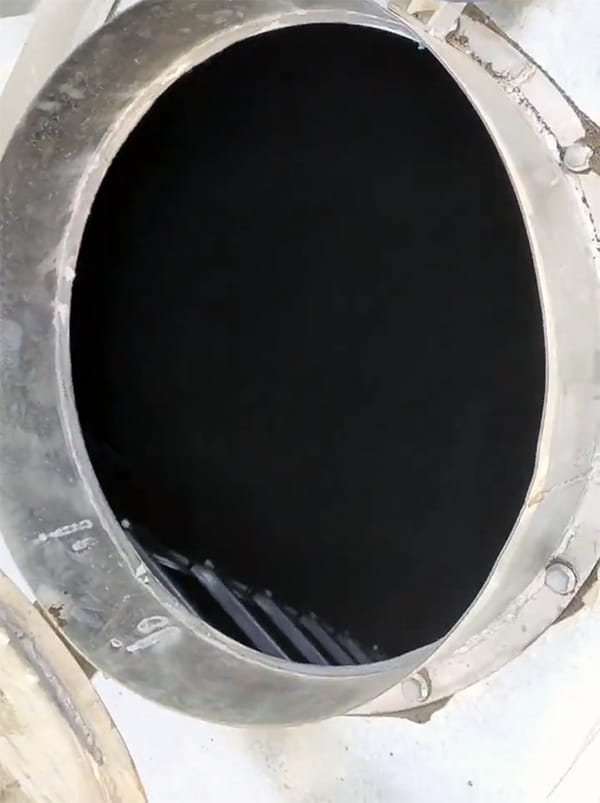
And its four folded edges ensure its airtightness.
Its installation position is close to the roof ladder.
Air Vent
A hose connects this air vent with the outlet of the bottom air fan.
When you need to cool down the grain in the bin, open the air vent and then turn on the aeration system.
Please also remember to open the natural vent on the roof, and if necessary, start the axial fan on the roof.
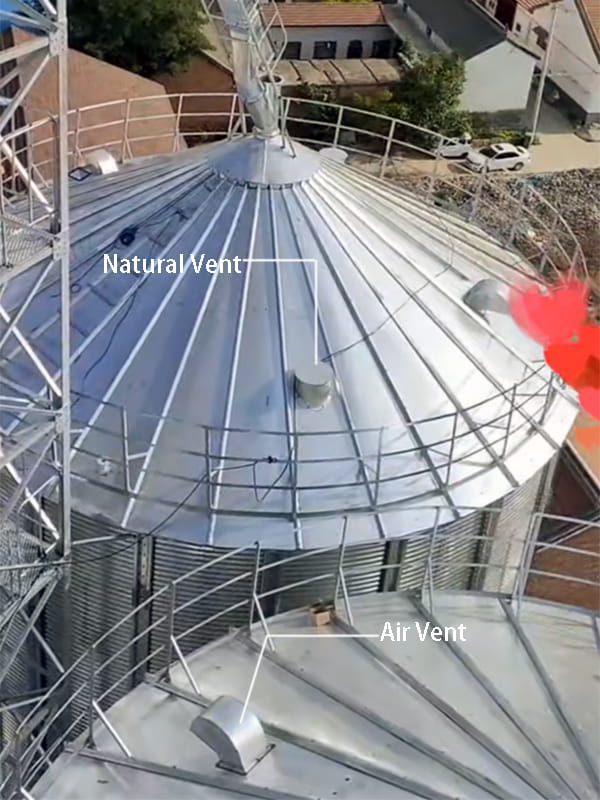
Natural Vent
Natural vents consist of a cap, a duct & a flange.
You can open this vent when the weather conditions are good, the hot air and wind pressure promote the gas exchange inside and outside the steel silo, balancing the temperature and humidity of the grain in the silo.
However, the efficiency of natural ventilation is low and limited by weather and geographical conditions.
You’d better check the grain situation in the bin frequently, and open or close the aeration system according to the temperature and humidity changes of the grain in the bin.
Handrail
The handrails on the roof may refer to the handrails on both sides of the roof ladder;
It could also be the handrail that surrounds the eave walkway.
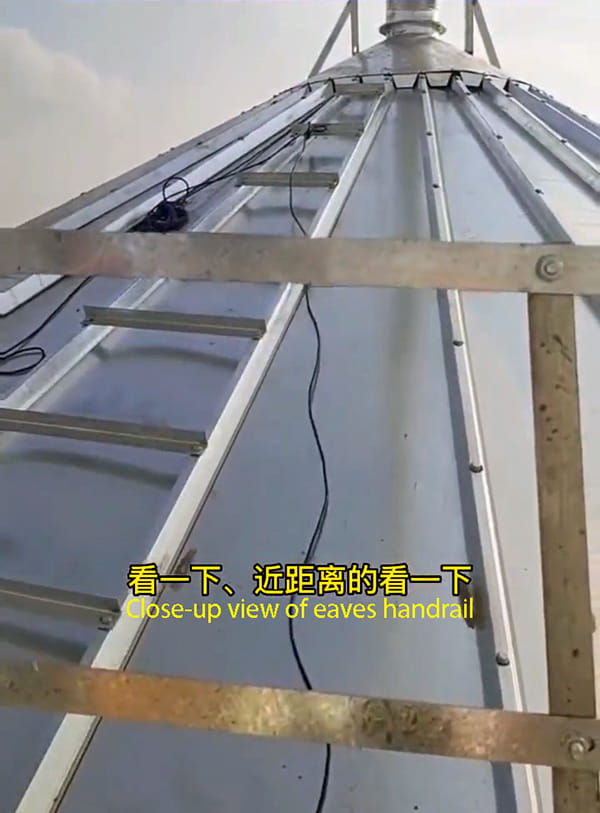
Some customers will request to add walkways and handrails to the roof eaves, facilitating workers to inspect the roof, and protecting the safety of workers.
Cylindrical Body
The cylindrical body of the steel grain silo includes the items below:
Sidewall Sheet
When installing the cylindrical body of the steel silo, workers connect 1.12-meter-high curved corrugated panels to form a ring, and then stack rings from top to bottom to form a cylinder.
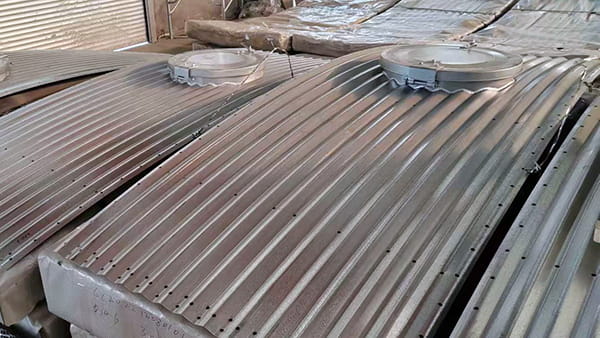
As the main component of the cylindrical body, the corrugated panels come out from a silo roll forming machine, which consists of an unwinder, feeding leveler, hydraulic punch press, hydraulic cutter, and online curving machine.
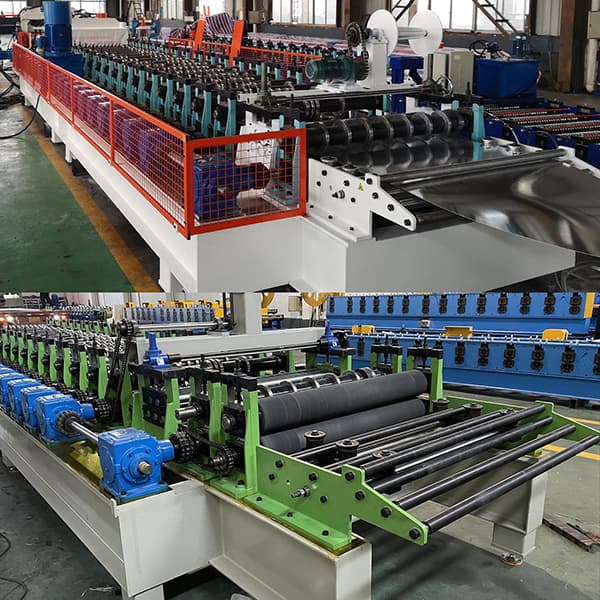
The curved corrugated sheets produced by a silo roll forming machine not only have a beautiful appearance, but also have high precision and compatibility, and are easy to assemble.
After assembly, the corrugated panels have a good fit and strong sealing.
Stiffener
The Ω-shaped stiffener is installed on the outside of the sidewall sheet to share the vertical load of the entire steel silo.
As an important part of the cylindrical body, it determines the overall stability of the silo.
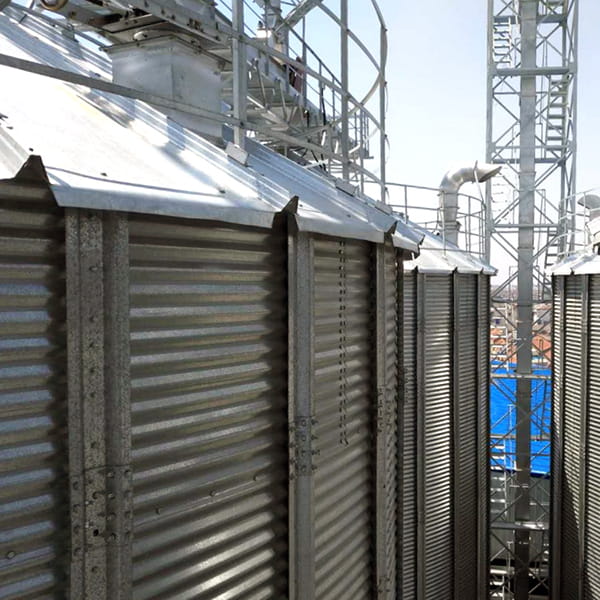
The stiffeners are formed at one time on a large hydroforming press, and the load-bearing capacity is 10% higher than that of traditional production.
Each sidewall sheet can have 2 or 3 stiffeners spaced 1.2m or 0.8m apart.
Wind Ring
The wind ring is made of high-strength hot-dip galvanized steel pipe, which is connected to the stiffener.
With wind rings reinforce the cylinder, which can avoid silo deformation due to wind pressure after emptying the grain.
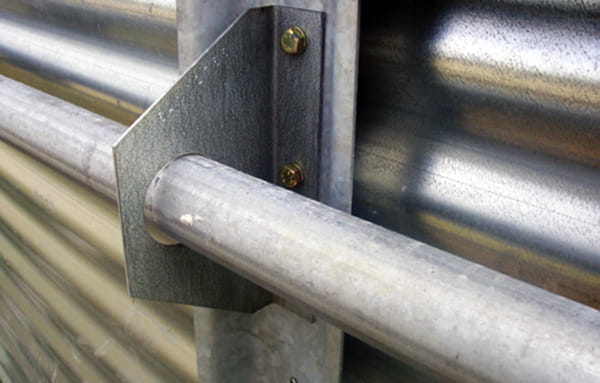
Generally speaking, from the roof eave to the bottom of the silo, you’d better add a wind ring every two corrugated panel rings.
If possible, install as many wind rings as possible.
Access Door
The access door is a standard component of the steel silo, through which workers enter the silo for maintenance.
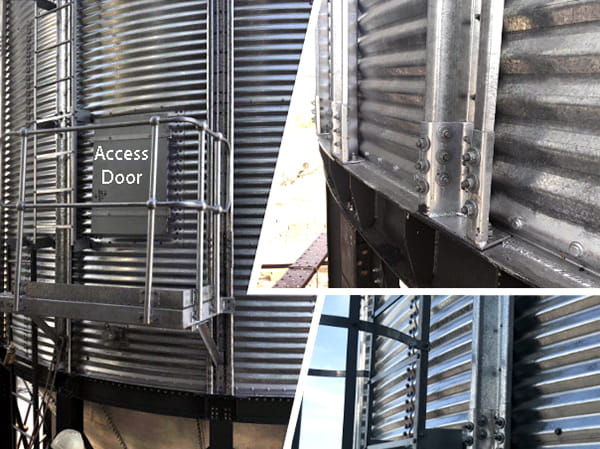
It consists of an inner plate and an outer plate, which are screwed together by a hinge, and is usually installed on a specific sidewall sheet, usually the 2nd corrugated sheet ring from the bottom of the bin.
Bottom
The bottom of the flat silo & hopper silo are different, let’s introduce them respectively.
Flat Silo Bottom
Some additional accessories are common at the inside bottom of the flat silo:
Sweep Auger
The sweep auger consists of a gearbox, a screw shaft, a screw blade, and a back shield.
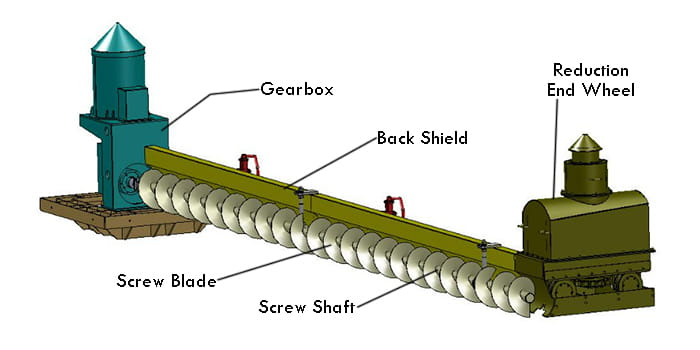
One end of the screw shaft connects to the gearbox located in the center of the silo, and the other end is a movable reduction end wheel.
In addition to the axial movement, the screw shaft and the screw blade will also move circularly along the silo with the gearbox as the center.
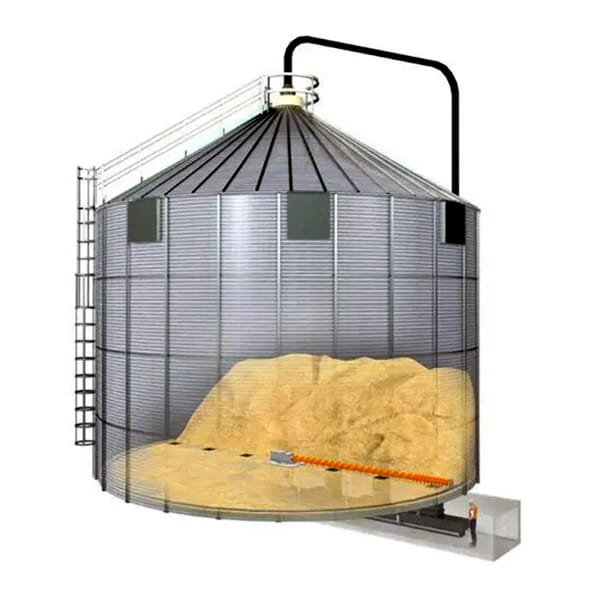
When unloading the material, most of the material first flows out from the center outlet of the bin by gravity.
After the self-flow is over, open the intermediate outlets, and part of the material accumulated on the sweep auger will flow out naturally.
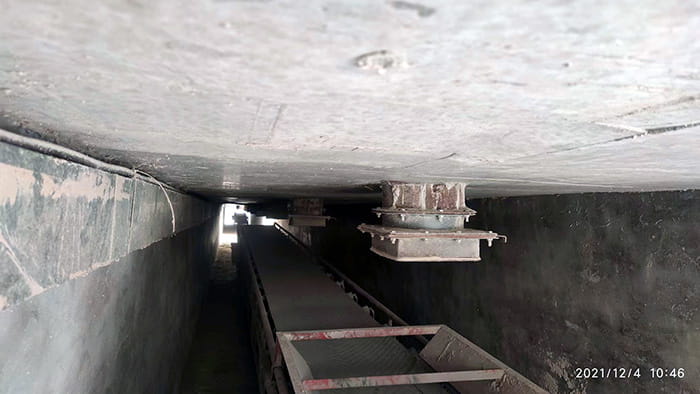
After reducing the load of the sweep auger, start it to clean up the accumulated materials.
When cleaning materials with poor fluidity, start the sweep auger directly without waiting for most of the materials to flow out naturally.
In this case, the structure of the sweep auger will be more special, and the power will be higher.
Aeration Gutter
It is made of hot-dip galvanized steel and installed on the concrete foundation of the silo, “Y”, “H” and “C” layouts are available for you to choose from.
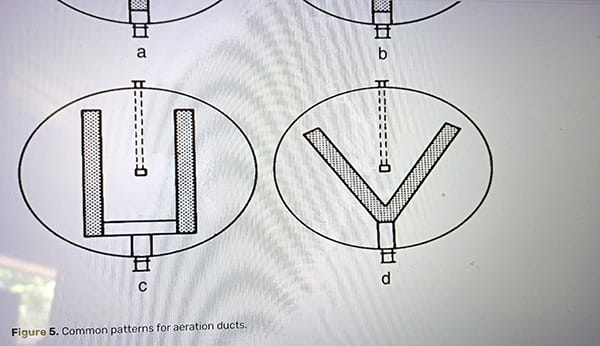
According to the silo size, grain volume, etc., the thickness of the galvanized steel sheet is customizable as per your request.
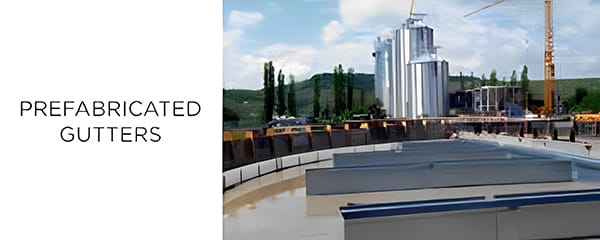
Perforated Floor
The aeration channel is made of perforated metal sheets with a galvanized surface, corrugated, and small holes 1 or 1.5 mm in diameter.
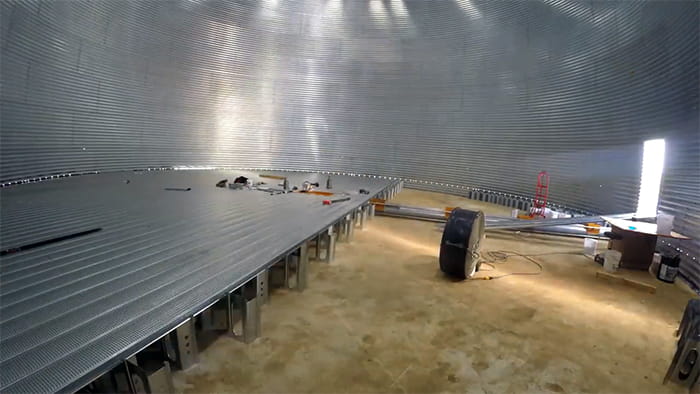
The channel distribution is “Y” or “H”, depending on the type and volume of the stored grain.
There is a gutter support under the perforated floor to make the airflow better.
Hopper Silo Bottom
For hopper silo bottom, it includes:
Hopper Cone
Trapezoidal galvanized steel sheets are assembled one by one to form a hopper shape.
Its top connects to the cylinder body, its bottom links to the support structure, and the level detector and ventilation ducts attach to its inner surface.
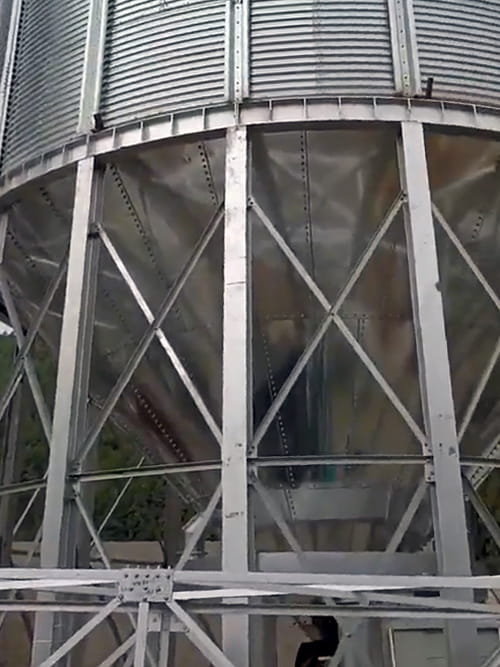
In order to facilitate the aeration system operation, manufacturers usually prefabricate a reserved hole for air fan ducts.
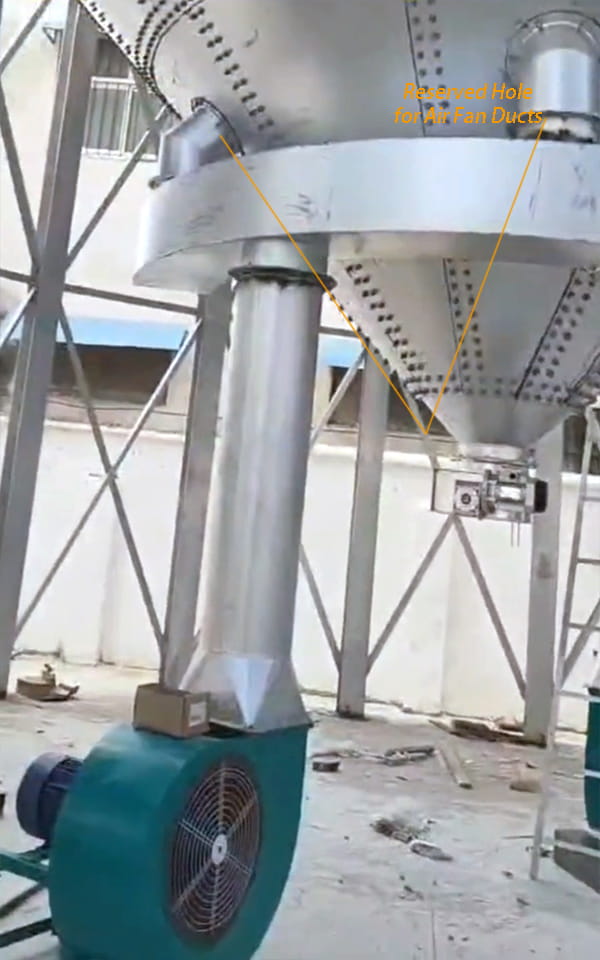
There is a slide gate at its very bottom for material unloading.
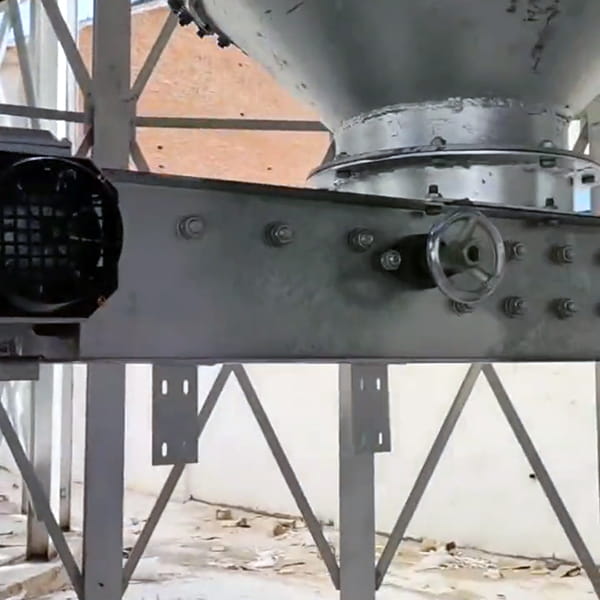
Compression Ring
When you need to increase the support structure’s ability to withstand peak vertical loads, you need to add compression rings to the support structure.
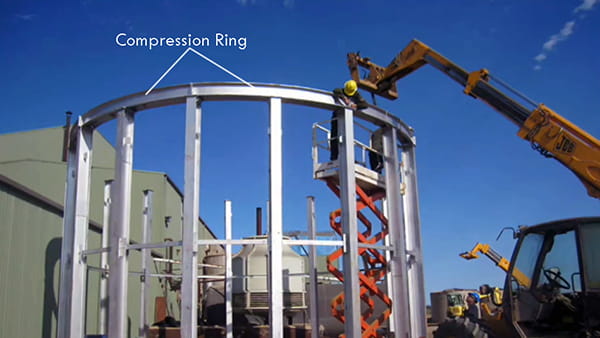
The outer side of the compression ring is fixed on the cylindrical body panels and stiffeners, and the inner side is fixed on the hopper cone and stands on the supporting structure.
Support Structure
Steel columns connected by bracings with anchor plates at the top and bottom.
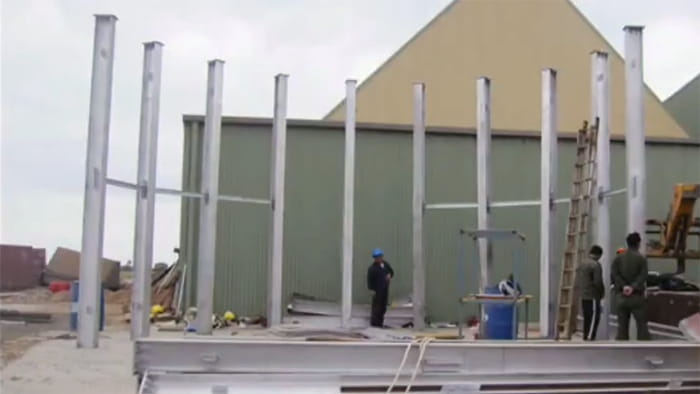
Its top connects to the cylindrical body and its bottom links to the foundation.
Control System
The control systems listed below are common in metal bins.
Grain Monitor & Control System
With temperature measuring cables, material level & temperature sensors, real-time monitoring of the temperature & humidity of the grain is achievable.
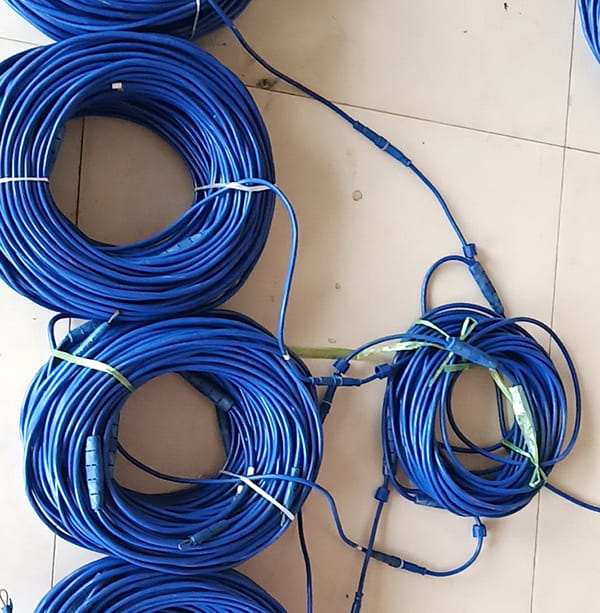
Aeration System
When the monitor & control system detects that the grain temperature exceeds the standard, it will automatically start the ventilation fan.
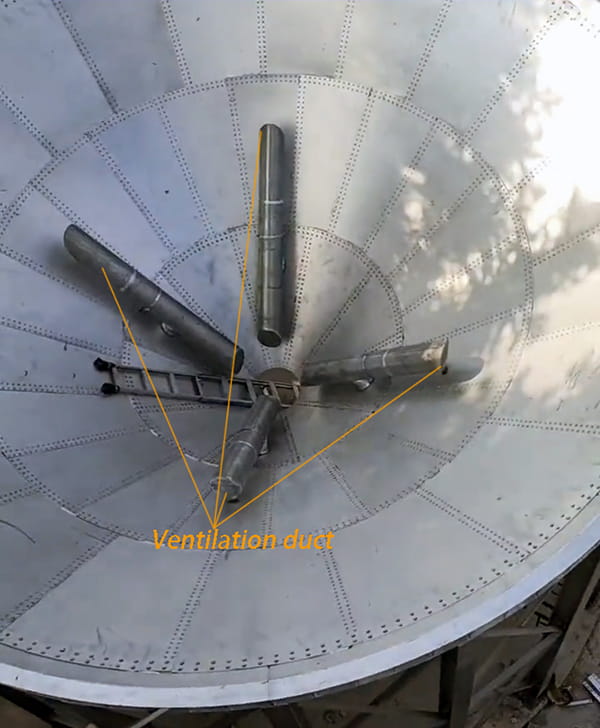
Thus, the heat exchange between the cold air & the material occurs and finally achieves the cooling & dehumidifying of the grain.
Grain Cooling System
Through the grain chiller, the grain temperature in the silo drops, and low-temperature refrigeration comes to reality.
The grain “breathing” slows, the reproduction of grain insects pauses, the cost of pest control reduces, the quality of stored grain improves, and the storage time extends, thus realizing grain storage safety.
Fumigation System
This system is helpful for controlling pest damage in grains & reducing waste.
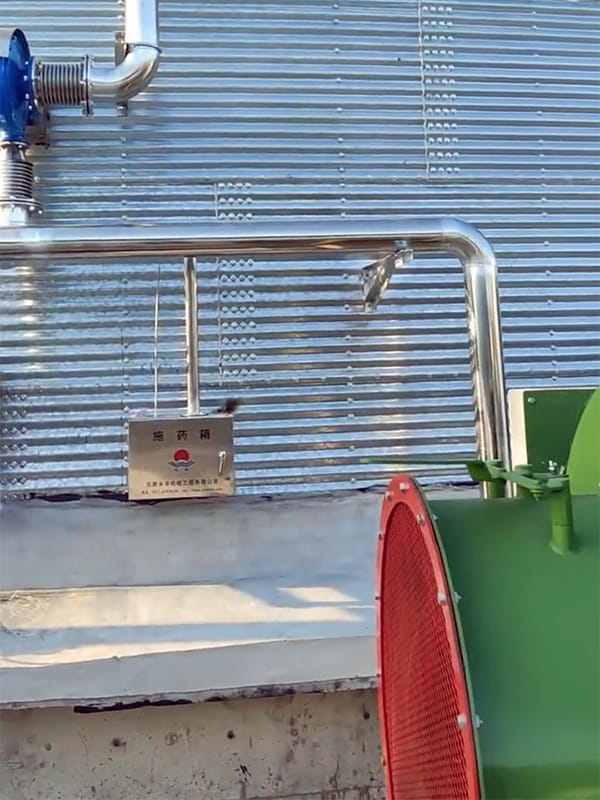
Auxiliary Equipment
The normal operation of the metal grain bin requires the following auxiliary equipment from time to time.
Bucket Elevator
The bucket elevator is conveying equipment that conveys grain vertically upward without damaging the material.
Its material is hot-dip galvanized steel, carbon steel, or stainless steel according to special needs.
In the metal silo project, it is responsible for receiving the material from the scraper conveyor, lifting the material to the roof height, and then pouring it into the scraper conveyor or feeding chute.
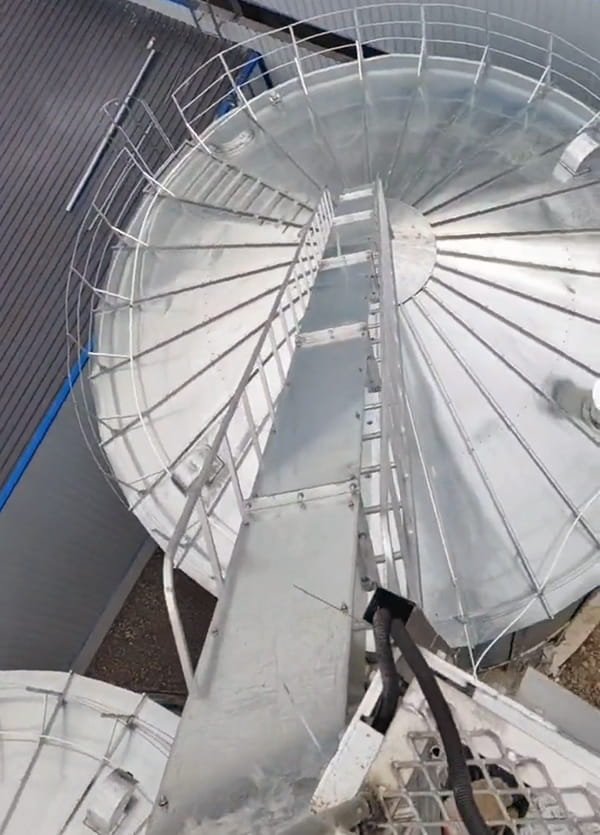
- Refined rubber-covered head, wear-resistant, prevents the belt from slipping, safe operation with a full load;
- Lightweight & high-strength plastic bucket, low breakage rate, long service life, and bucket material is customizable;
- High-strength nylon belt with low elongation;
- Welded casing by cold-rolled steel sheet, with good strength and sealing performance;
- Well-known motors and reducers, simple installation & maintenance;
- Optional speed & belt deviation detection system;
- Emergency buttons at several points.
Drag Conveyor
The drag conveyor is a large-capacity conveying device, which is capable of transporting bulk materials horizontally and upwardly. Its main material is hot-dip galvanized steel, painted steel, or stainless steel according to customer requirements.
When it is running, the chain driven by the reducer drags a series of paddles (or blades), and these paddles drag the material along the material flow direction.
In the corrugated steel silo project, the dray conveyor transports the granular, flake, or powder materials from the dump pit to the elevator horizontally, and is also responsible for loading the materials from the bucket elevator to the steel silo.
- Manganese steel chain, high tensile strength, long service life;
- Profiled steel sheet & angle steel welded, high strength, and great sealing;
- Polymer wear-resistant material guide rails eliminate sliding noise and reduce power consumption;
- Flexible process layout, multi-point discharge, quick open inspection window;
- Adjustable speed, anti-blocking & anti-broken chain device, safe and reliable;
- Computer-aided design, accurate motor & reducer matching, high efficiency & energy saving;
- Simple assembly and maintenance.
Drum Pre-cleaner
The pre-cleaning system is an important piece of equipment for the steel silo project, which effectively improves the quality & stability of grain storage.
In order to ensure the impurity removal effect, SiroSilo recommends that you choose a double-drum pre-cleaner.
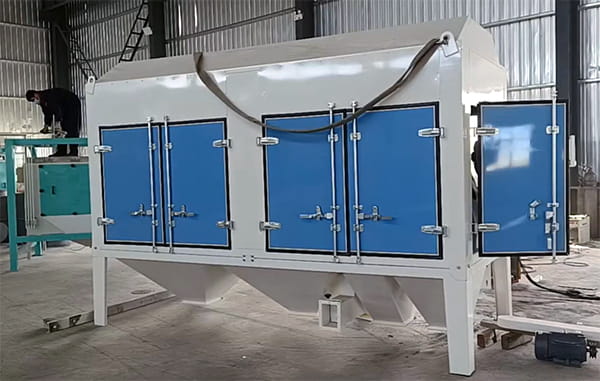
The double-drum pre-cleaner separates various impurities such as dust, branches, weeds, etc. from different types of grains (barley, wheat, rice, soybeans, corn, rapeseed, etc.).
It has a good impurity removal effect, and its processing capacity ranges from 20 tons/h to 180 tons/h.
- Beautiful appearance, compact structure, long service life;
- High-strength structural design, high cleaning efficiency, and low energy consumption;
- Adjustable sieve hole diameter according to the material;
- Sieve is controllable by sampling control points;
- Adjustable drum inclination angle by automation, separating large, medium, and small impurities simultaneously;
- Adjustable drum rotation speed;
- Simple installation, convenient maintenance, and easy replacement of the drum.
Dust Collecting Systems
During the grain loading and unloading processes of the galvanized steel silo, they generate a large amount of dust, and many grain processing plants will introduce dust collecting systems to meet the requirements of environmental protection.
The dust collecting system consists of a centrifugal fan, pipeline, cyclone separator, pulse dust collector, rotary airlock valve, etc.
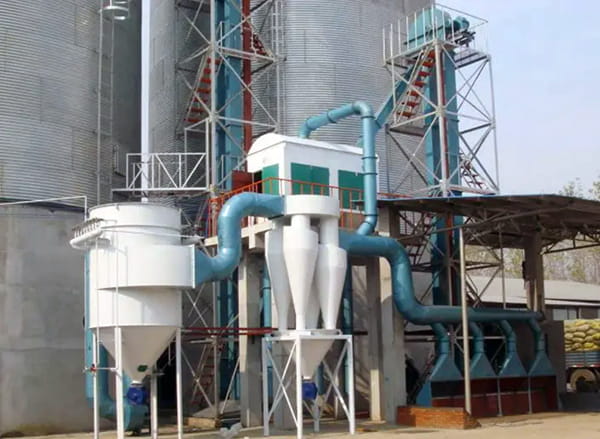
A centrifugal fan draws the dusty air into the pipeline, and the dusty air first passes through the cyclone separator to remove large particles of dust.
Then the dusty air exits the top of the cyclone separator and enters the pulse dust collector.
The pulse dust collector separates air & particulate dust, then discharges clean air through its top outlet.
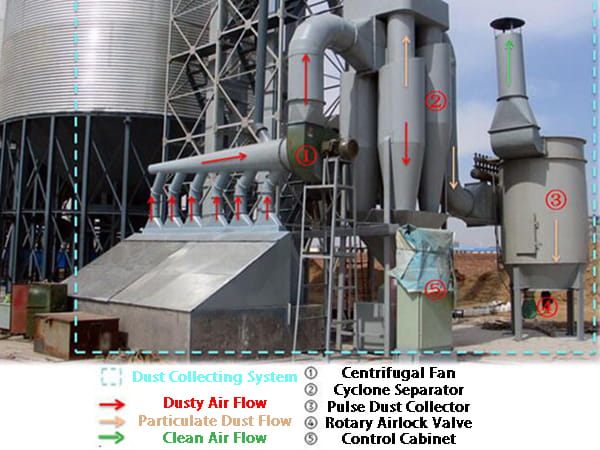
Magnetic Drum Separator
From harvesting to processing, grain has to go through many steps, during which various metal substances such as iron nails, screw washers, etc. will be mixed.
If these metal substances enter the high-speed machine with the grain, they will seriously damage the machine parts; or even generate sparks due to collision & friction, causing a dust explosion accident.
At the same time, during processing, due to the wear or oxidation of machine parts, some metal debris or powder will also appear.
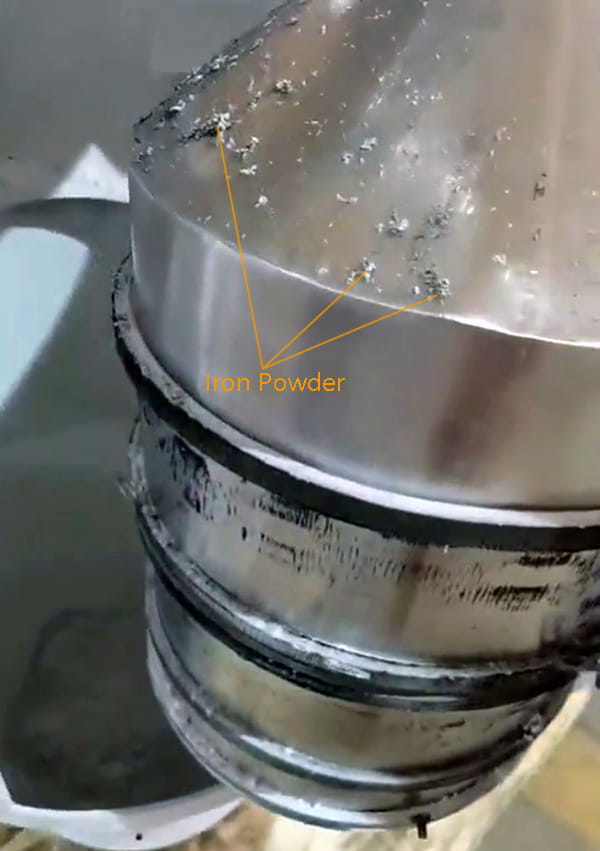
When these impurities are mixed into the grain, it will endanger human health; if mixed with feed, it will also hinder the raising of livestock.
It is necessary to take suitable measures to remove these metal impurities, and magnetic separation is the answer.
Many food factories have introduced magnetic drum separators to clean up magnetic metal impurities.
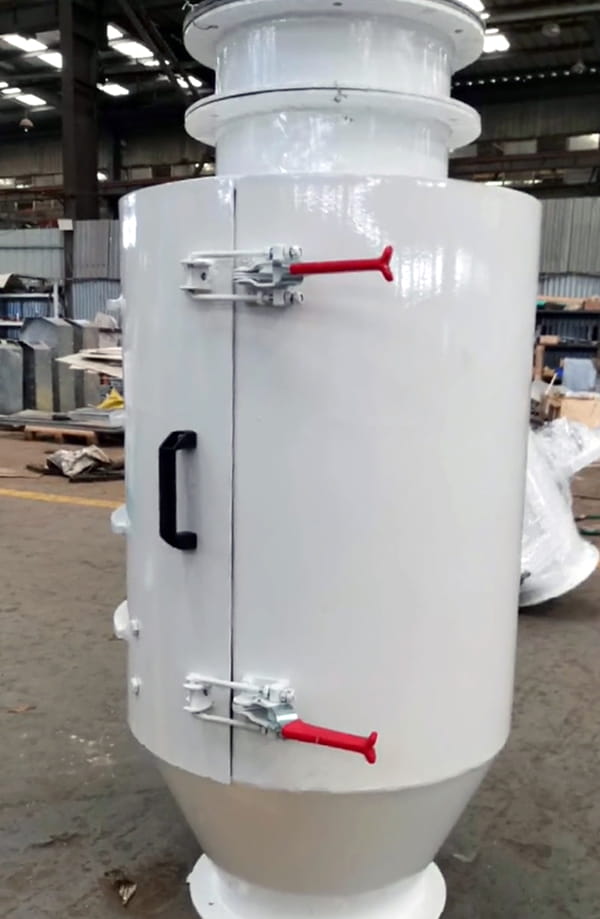
Grain is a non-magnetic material and can pass through the magnetic drum separator freely;
And any magnetic substances (Fe, Co, Ni elements and their alloys, some Mn compounds, rare earth elements, and their alloys, etc.) are adsorbed by the magnetic drum and separated from the grain.
Belt Conveyor
A belt conveyor is one of the common material conveying equipment. It consists of a frame, conveyor belt, idler roller, motorized pulley, tensioning device, transmission device, and so on.
There are two pulleys at both ends of the machine, a row of idler rollers locate between the two pulleys, and the belt wraps around the pulleys at both ends and rides on the idler rollers.
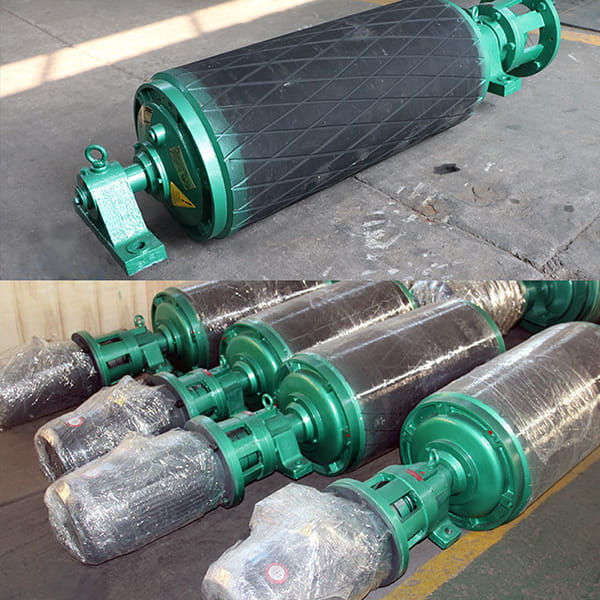
The motor drives the reducer first, then the reducer drives the drum pulley at the discharge end to rotate, and the friction between the drum pulley and the belt moves the belt to realize continuous conveying of materials.
It is suitable for conveying materials with a bulk density of less than 1.67 tons per cubic meter, suitable for conveying both bulk, granular, and blocky materials.
For flour mills, feed processing plants, oil plants, starch plants, mining farms, and chemical plants with metal silos, they often introduce belt conveyors to transport soybeans, corn, sorghum, rice, wheat, flour, minerals, cement, etc.
The belt conveyor can work alone, and can also co-work with other conveying equipment to form a horizontal or inclined conveying system to meet the needs of different customers.
- Long conveying distance;
- Large volume conveying;
- Fast speed, adjustable height;
- Strong versatility;
- Automatic and centralized control;
- Low material breakage rate;
- Easy to install, operate, maintain, and disassemble;
- Deviation correction, emergency stop, speed regulation, safety detection device;
- Rubber-covered drum pulley to increase friction;
- Quickly releasable belt tension;
- Customizable steel cover to ensure air tightness.
Screw Conveyor
A screw conveyor is a common material conveying equipment for grain steel silo projects.
For a screw conveyor, a motor drives the spiral blade to rotate and push the material.
It is suitable for conveying granular or powdery materials, and it cannot convey bulky, corrosive, fragile, or quickly bonded materials.
Mining plants, chemical plants, flour mills, feed processing plants, and oil plants often introduce screw conveyors to transport soybeans, rice, sorghum, corn, wheat, etc.
- Simple structure, small cross-sectional size;
- Synchronous conveying and stirring;
- Sealed transportation to reduce pollution;
- Loading and unloading at any point of the horizontal screw conveyor;
- Control the forward and reverse rotation of the motor to realize two-way transmission;
- Easy maintenance;
- Relatively cheap.
Air Fan
Fan intake and cool air, greatly reduce air temperature and humidity and then blows the air into the silo through the aeration channel and the gutter.
Cooled air carries the heat and moisture in the grain to the roof vent.
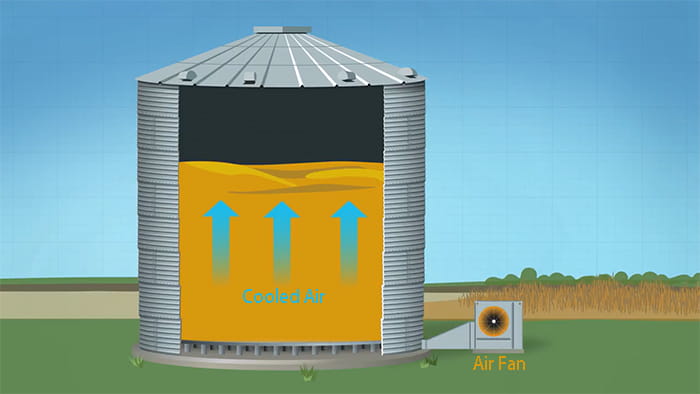
Larger steel silos introduce multiple fans and aeration ducts for ventilation.
 SiroSilo
SiroSilo